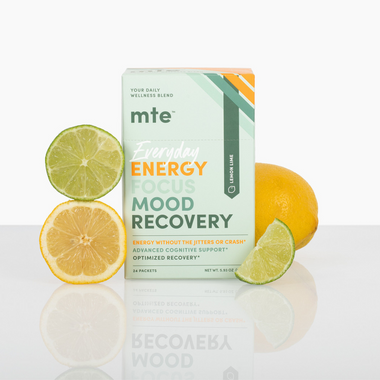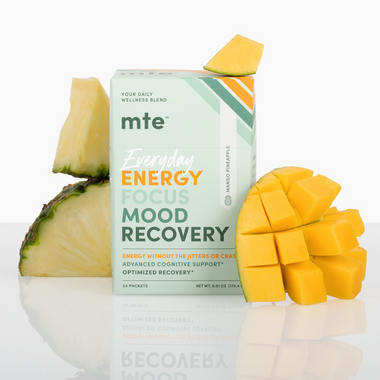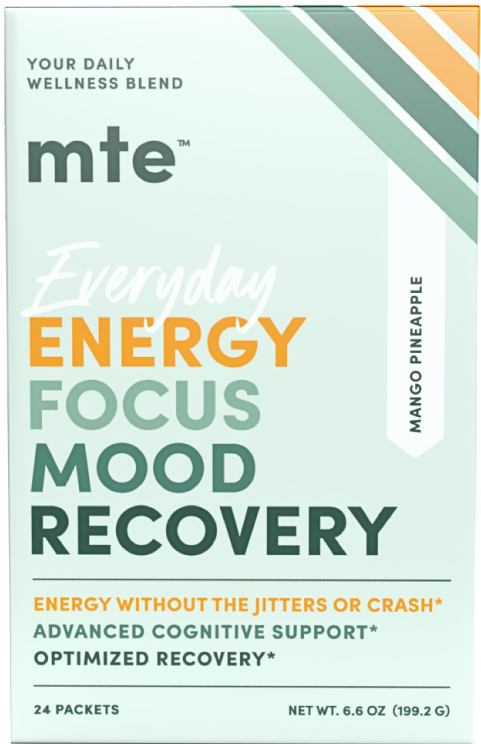
Can MTE’s Adaptogens Help Ease Migraines & Reduce Triggers?
Wake up, get stressed, migraine hits. Sound familiar?
That’s because stress is one of the most common migraine triggers. In fact, it often only takes one hectic meeting, an incoming deadline, or everyday chaos to set off that familiar pounding in your head.
The worst thing is that you can’t really avoid stress. And sure, you can pop a painkiller, but that’s just a band-aid for the real problem. Without addressing the cause, migraines keep coming back.
So, how do you address the problem if stress is inevitable?
A good way is to use an adaptogen stack for stress, inflammation and immunity. Adaptogens help our bodies respond to stress more effectively and protect from the effects of stress on a biological level. When our systems can resist stress more effectively, it’s less likely to escalate into a migraine.
Let’s explore why migraines happen and how MTE’s adaptogens can help manage the triggers.
More Than a Headache: What Are Migraines?
Migraine is a neurological condition that causes intense pain, usually on one side of the head. Many people with chronic migraines report auras (light blurs/halos) that signal the onset of a migraine. People with ocular migraines may actually experience visual disturbances as a warning sign there’s a migraine building.
Migraines can last anywhere from a few minutes to several days. They are more than just a bad headache. In fact, they often come with additional symptoms like sensitivity to light and sound, nausea, vomiting, impaired executive function, and temporary visual impairments. A migraine attack can be so bad that it makes it impossible to concentrate, work, or even move around.
Migraines affect millions of people worldwide and can range from infrequent, mild episodes to chronic, life-altering conditions. In the US, researchers estimate that one in six adults suffers from migraines.
So, why do people get migraines, and what’s really going on in our throbbing heads?
Medical Mysteries: Why Do People Get Migraines?
With migraines being so common, we must know a lot about them, right? RIGHT?
Well, not really. Despite affecting millions, migraines remain a bit of a medical mystery, which is also why no one has found a widely effective treatment for chronic migraines. We do know that genetic, environmental, and neurological factors contribute to migraines. In other words, it’s not just one thing that causes a migraine, it’s a combination of factors.
There are several theories about the mechanisms of migraines, but the gist is that it’s got a lot to do with (1) inflammation and (2) dysfunctional chemical signaling. However, no one has identified a specific neurotransmitter or other chemical signaler that acts as a control switch for where, when and how a migraine onsets, or for why it eventually ends.
What Are the Most Common Migraine Triggers?
If you suffer from migraines, you’ve probably noticed that certain things can set them off. And while everyone’s triggers are a little different, there are some usual suspects that seem to affect most migraine sufferers:
- Stress – Stress causes your body to release chemicals like cortisol and adrenaline, which tighten blood vessels and increase inflammation.
- Hormonal changes – Fluctuations in estrogen, particularly during menstruation, pregnancy, or menopause, can disrupt the brain’s chemical balance.
- Lack of sleep – When you don’t get enough rest, it can lead to changes in brain function and make you more prone to migraines.
- Diet – Certain foods (like caffeine and alcohol) contain compounds that affect the brain, while skipping meals can lead to low blood sugar, both of which can trigger migraines.
- Weather changes – Sudden changes in barometric pressure can affect the blood flow to your brain, which may trigger migraines, especially for those sensitive to environmental shifts.
- Bright lights – Intense lights or flickering screens cause overstimulation of the brain’s visual cortex, which can lead to sensory overload.
- Strong smells – Scents like perfume, smoke, or chemical fumes activate the brain’s trigeminal nerve, which is involved in sensory perception and can trigger migraine pain.
If caffeine triggers your headaches, you can try a caffeine-free energy drink powder to support your focus and productivity.
Why is Stress Such a Common Trigger for Migraines?
When we’re under stress, our bodies hit the panic button, activating the sympathetic nervous system. This tells your brain to flood the bloodstream with cortisol, which is the body’s stress response hormone, and norepinephrine, the most enthusiastic of the LET’S F*CKING GO neurotransmitters. It’s part of the fight-flight-freeze response that prepares us to handle perceived threats, and it used to be crucial for survival. Nowadays, not so much.
The problem is that our brains haven’t quite figured out the difference between being chased by a hungry sabertooth cat and preparing for a stressful meeting. In the modern world, we deal with constant stress, but it's (mostly) low stakes, not life-or-death. Your lizard brain doesn’t know that, though, which is why it keeps pumping out cortisol like there’s no tomorrow even though all that’s happened is you’re fatigued and frustrated with your overly busy schedule.
This flood of cortisol creates a ripple effect – it increases inflammation, raises your heart rate, and tightens blood vessels, all of which can contribute to that throbbing, mind-numbing migraine pain. And that’s just in the moment, because chronic stress knocks over key players in almost every system in your body, throwing everything out of whack.
Over time, chronic raised cortisol levels exhaust your nervous system and deplete your brain of key neurochemicals it needs for focus, mood, energy, sleep, digestion – literally everything. The longer there’s a surplus of cortisol in your bloodstream, the more often your immune system is depressed, leading to worse health outcomes.
Adaptogens for Stress: A Resource for Migraine Attacks?
You’re rolling your eyes at your phone thinking, Okay, great. Except the part where I can’t avoid chronic stress because I exist in the world. Now I’m stressed about being stressed, tysm.
Hold up, though. Have you thought about an adaptogen stack for stress and inflammation? Might be the solution to the stress-migraine catch-22.
Adaptogens are natural plants, mushrooms, herbs, and algae that help the body adapt to stress. Most adaptogens offer many stress resilience benefits, from protecting DNA integrity to stress-induced stomach ulcers, lowered cortisol levels, raised feel-good neurotransmitters, and more.
That’s because adaptogens act systemically. They help various excitatory and inhibitory chemicals communicate effectively. Over time, this brings systems back into balance and everything runs more smoothly. This is why they should be taken as part of a daily wellness blend to experience their full effects.
Adaptogens also have anti-inflammatory properties that help cool down the body’s inflammatory response. The best thing is that adaptogenic effects stack over time, so the more you take them, the better your body gets at dealing with stress and inflammation.
That way, instead of trying to fight symptoms when the migraine hits, you try to prevent the attack before it begins. More stress resilience may translate to more resilience to migraines, especially if you have a consistent source of the most potent adaptogens traditional medicines and modern science indicate boost stress resilience and fight inflammation.
MTE’s Key Ingredients for Migraine Management
MTE is a healthy energy and wellness blend of 10 adaptogens, nootropics, and superfoods into a powerful formulation that supports well-being, including mood, focus, sleep, inflammation, and more. As a daily wellness companion, the stress-fighting ingredients in our adaptogen stack may also support migraine reduction and recovery.
All of MTE’s ingredients offer unique benefits, but a few stand out for their potential to help manage migraines by addressing two of the biggest culprits – dysregulation and inflammation.
Let’s take a look at a few:
Ashwagandha
Ashwagandha has been used in Ayurvedic medicine for thousands of years to support the immune system, vitality, and physical endurance. Packed healthy bioactive compounds, one of ashwagandha’s biggest talents is modulating the HPA axis, which controls the body’s stress response. Balanced HPA axis = less cortisol seeping into everything.
A cool thing about ashwagandha – since it’s an adaptogen, you build more resilience when you consume it regularly. Over time, it promotes better resilience to stress and better recovery because your body doesn’t go into a cortisol overdrive when you’re feeling pressure.
However, we must mention that the benefits aren’t instant. Ashwagandha won’t do much if you’re already in the middle of a migraine attack. But if you take it regularly, it can strengthen your migraine prevention routine, as you’re already supported against stress and reactivity.
GABA (Gamma-Aminobutyric Acid)
When we’re feeling stressed, anxious, or overstimulated, our neurons start firing signals like crazy. GABA’s job is to step in and slow things down. It binds to specific receptors in the brain to reduce the firing of neurons. It’s kind of like a volume dial for your brain’s activity – it turns down the intensity when things are too loud.
Since migraines often occur when there’s abnormal nerve signaling, increasing GABA levels can effectively reduce the chances of nerve overactivity that triggers these attacks. This calms your mind and also eases the physical tension that often accompanies migraines.
There’s also an important relationship between GABA and glutamate, another neurotransmitter in the brain. While GABA inhibits neuron activity, glutamate does the opposite.
There’s a delicate balance between these two chemicals, but research suggests that people who suffer from migraines tend to have higher levels of glutamate. So, increasing GABA could help balance out this overactivity and prevent the excess excitation that often leads to migraines.
Maca
Back to the HPA axis, maca is a little cruciferous root that’s both a superfood and an adaptogen. A 2024 review of the body of scientific studies on maca’s bioactivity cited many studies that demonstrate its stressbusting, anxiety-quieting properties. Maca directly intervenes with the sympathetic nervous system, which is the one responsible for opening the cortisol floodgates via the adrenal cortex.
Studies have also seen it increase hippocampal neurogenesis (better stress resilience) and boost serotonergic activity (better mood, motivation, sleep). Yet more studies have seen it improve sleep, low mood, and anxiety symptoms. For those of us with chronic migraines, we’re well aware those three things coalesce into a rat king of having a terrible time, which only makes migraines more likely, more frequent, and more painful.
Addressing the Inflammation Issue
Of all the things we don’t really know about migraines, researchers are pretty sure inflammation plays a role. After all, inflammation plays a role in pretty much everything; why not this, too. And why else would there be caffeine in, like, every OTC migraine medication? Luckily, that was well on our radar when we formulated MTE. Ashwagandha and maca are anti-inflammatory, too, but so are spirulina and chicory root, which you’ll also find in our mood-boosting, stress-relieving drink.
You’ve got the adaptogens to clear out the crowding of your stressed-out, fatigued mind, and you’ve got the superfoods to clear out the crowding of your stressed-out, fatigued body. Whatever they are, we know migraines are caused by some kind of imbalance, whether it’s hormonal, neurological, or physiological. With a daily adaptogen drink to mitigate imbalances, restore homeostasis, and increase resilience to the effects of stress, you’re fortressing yourself against migraine attacks.
How to Prevent Migraines Successfully
You shouldn’t wait for a migraine to strike, because by the time you know it’s coming, it’s often too late to stop it. The real goal should be to reduce your triggers and build resilience so migraines don’t have a chance to derail your day.
Here are a few simple habits that can help:
- Keep a migraine diary to help spot common triggers and patterns.
- Incorporate stress-management techniques like meditation, yoga, or deep breathing into your daily routine to lower your stress levels.
- Get enough sleep every night to allow your brain to clean up and restore balance.
- Drink plenty of water throughout the day, especially during exercise or hot weather.
- Pay attention to how your body reacts to specific foods and adjust your diet to avoid those that trigger migraines, like processed meats, aged cheeses, or alcohol.
- Exercise regularly to improve mood, boost sleep quality, and lower stress.
- Drink MTE to get a daily dose of adaptogens that help manage stress and fight off inflammation.
Stay One Step Ahead of Migraines with MTE
If you want to prevent migraines, you need to be proactive. Identify your triggers, learn stress-reducing techniques, improve your daily habits, and pay attention to your diet.
You can also add a holistic energy drink powder like MTE into your routine. With powerful adaptogens like ashwagandha, GABA, and eleuthero, MTE helps your body manage stress, reduce inflammation, and restore balance to out-of-whack systems. That’s exactly what you need if you want to cut down on those days lost to head-splitting migraines.
Looking to up your anti-migraine game? Make MTE part of your daily routine to optimize your health, feel better, do more, and live life as your best self.






